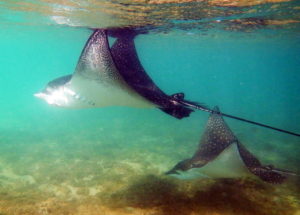
Of the 10 or so eagle ray species found in the Indian and Pacific Oceans, the spotted eagle ray (pair above) is the only one that inhabits Hawaii’s waters. ©Susan Scott
September 5, 2022
The last couple of times I went snorkeling in my favorite patch, I didn’t see my usual animal friends. The coral heads I visit were missing their usual lodgers, and no creatures showed themselves near or on the WWII forms that are now artificial reefs. I blamed this lack of action on my late morning starts. In my experience, the animals are more out and about at sunrise.
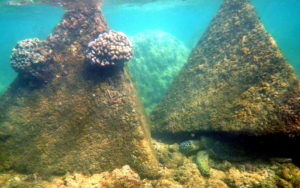
These concrete anti-landing craft structures were placed in Hawaii waters during WWII. Today, the ones that remain are home to countless marine animals. Corals grow on them and turtles tuck under for naps (lower right.) ©Susan Scott
But then, just I was wishing that Craig and I had gone earlier to the beach, a pair of fish gave us an experience of a lifetime. In the countless hours we’ve spent snorkeling and diving, this was our first time of swimming shoulder-to-shoulder with spotted eagle rays.
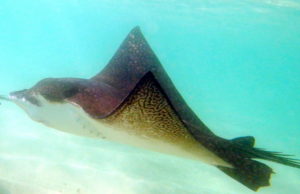
The undersides of an eagle ray’s fins have a mazelike pattern. ©Susan Scott
Eagle rays are kite-shaped fish with pointed fins that look, and flap, like wings. The bodies are dark brown or black, but often look deep blue, depending on the angle. These pictures of the same two rays hint at all three colors. White spots cover eagle ray backs. An adult eagle ray measures up to 10 feet wingtip-to-wingtip (ours were about 6 feet), and has a whiplike tail three times the body length. The base of each tail bears 3-to-5 toxin-loaded spines. (Sting rays have only one stinger. Manta rays have none.)
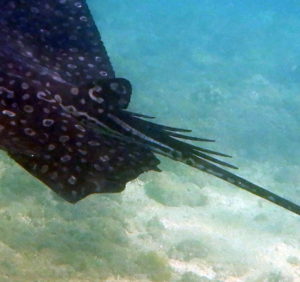
The larger of our two eagle rays had a full quiver of five stingers, used for defense only. The smaller ray had three. Eagle ray stings to humans occur only when a person is trying to handle a ray that was netted, hooked, or otherwise trapped. ©Susan Scott
We had just waded into thigh-deep water, and were donning our masks, when Craig pointed, and said, “Are those eagle rays?”
Eagle ray fins are distinct when they break the surface, and these tips were a sight we knew well from our sailing days. But my heart sank. Because of those venomous spines, my first though was, Oh, no, they’re in shallow water because they’re tangled in fishing line, and we won’t be able to help them.
Eagle ray stings are rare because although these rays dig in the ocean floor for their favorite food of snails, they never rest on the bottom like stingrays, and therefore, people can’t step on them. Rather, eagle rays soar in midwater, often in squadrons, performing underwater versions of the Navy’s Blue Angels shows.
Usually, these creatures keep their distance from swimmers and divers. Not these two. The splashing and tumbling of the rays was thankfully not due to monofilament entanglement. Rather, the two were mating.
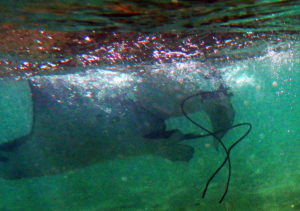
I turned my camera on just in time to catch eagle rays mating near the shoreline in about 4 feet of water. ©Susan Scott
Given their concentration on each other, the pair ignored us even after they separated, allowing us a few minutes to appreciate this special appearance.
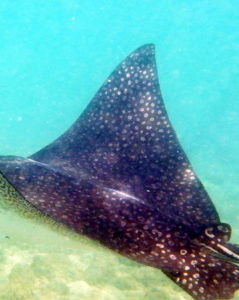
Each eagle ray has a unique spot pattern that allows researchers to identify individuals. ©Susan Scott
Spotted eagle ray females are pregnant 8-to-12 months, giving live birth by leaping from the water and dropping up to four pups. Hawaii residents have written me describing this amazing sight. Hopefully, this presumably-pregnant female will treat us ocean-goes to another extraordinary sight by delivering her babies near shore.
After a few minutes, the pair of eagle rays turned to deep water and disappeared, leaving me grateful that that day, I had a late start.
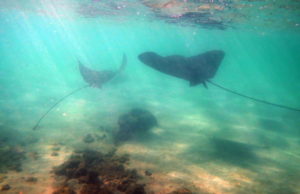
Eagle rays have two Hawaiian names: hailepo and hīhīmanu. Hīhīmanu also means magnificent.